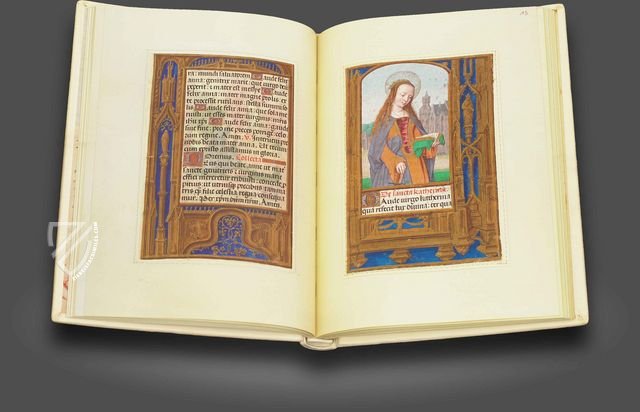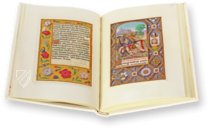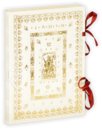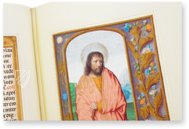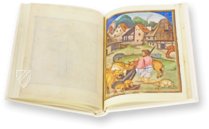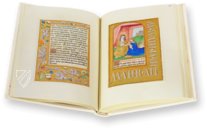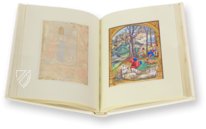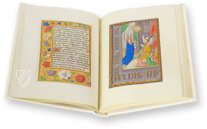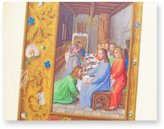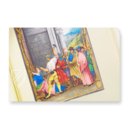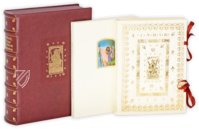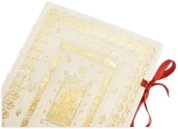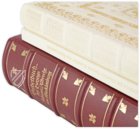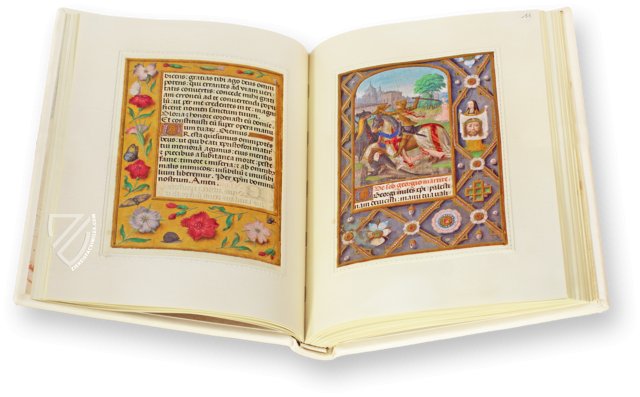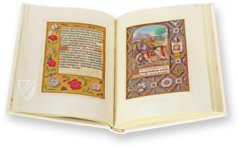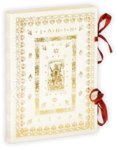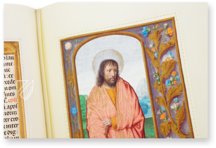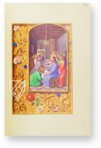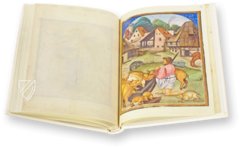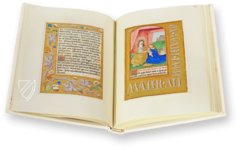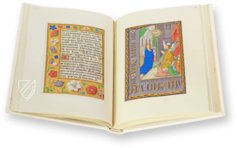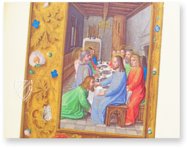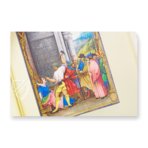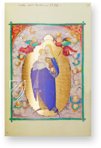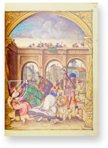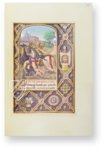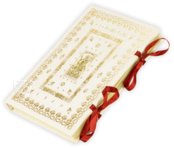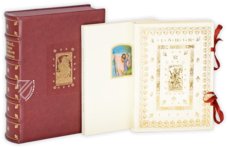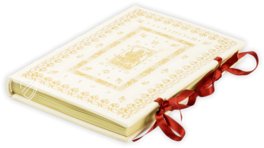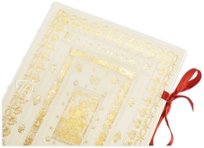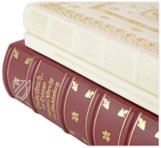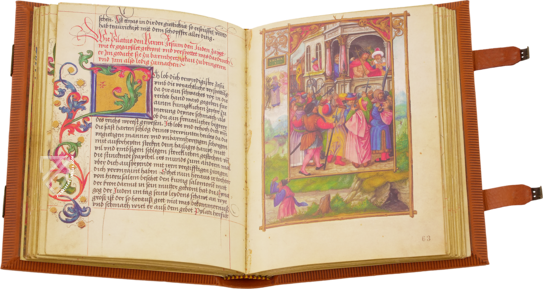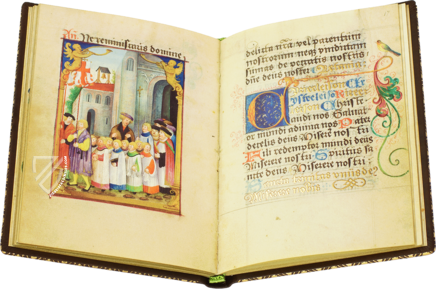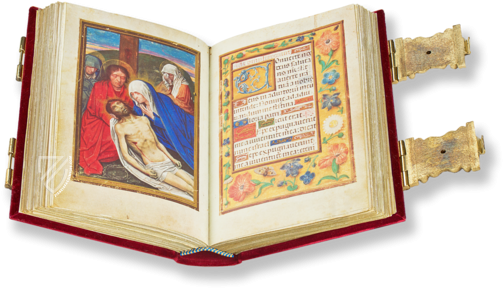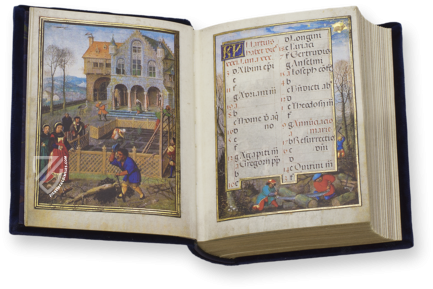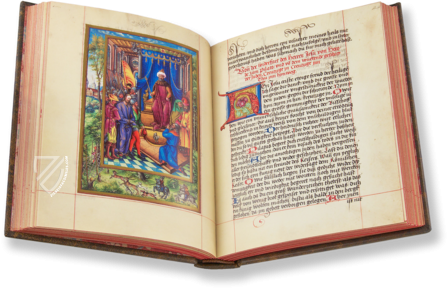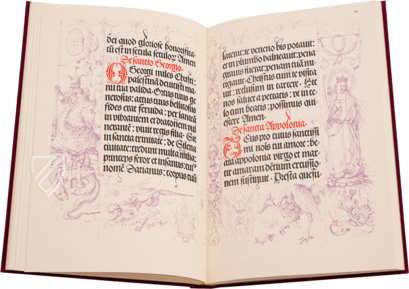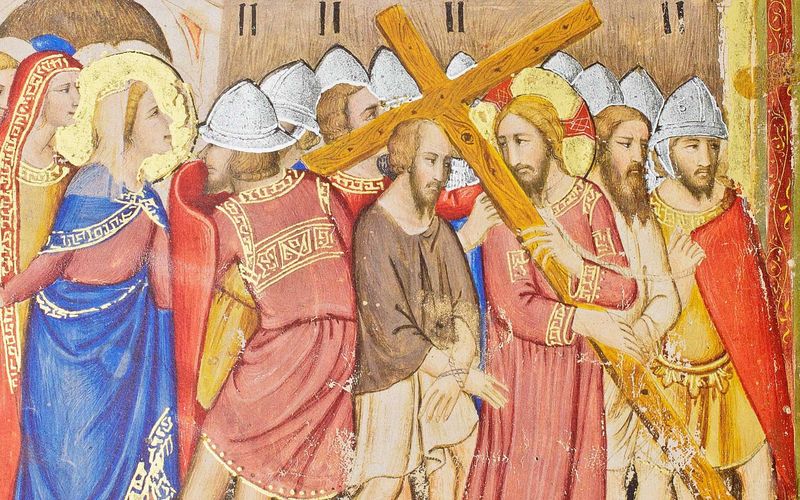Prayer Book of Duke John Albert I of Mecklenburg
An exceptional piece significant to art history: the so-called Prayer Book of Duke John Albert I of Mecklenburg. Contrary to a typical book of hours,this manuscript focuses explicitly on its visual décor with minimal text accompanying the miniatures. However, these miniatures are counted among the finest examples of 16th-century Renaissance book illumination: individual leaves by masters such as Simon Bening, Nikolaus and Albrecht Glockendon, and Sebald Beham were united into a marvelous compendium. Duke John Albert I of Mecklenburg (1525–1576) was responsible for it, he inherited the pages from the collection of his famous uncle, Cardinal Albert of Brandenburg (1490–1545), and then had them bound together into a single volume. The further history of the manuscript is also an adventurous tale. It was in this way that one of the most unusual manuscripts in the history of books and a true treasure of 16th century illumination came to be!
Prayer Book of Duke John Albert I of Mecklenburg
An exceptional piece significant to art history: the so-called Prayer Book of Duke John Albert I of Mecklenburg. Contrary to a typical book of hours, the focus of the manuscript is on the visual décor with minimal text accompanying the miniatures. These miniatures are counted among the best of what 15th century illumination produced. Individual sheets from Simon Bening, Nikolaus and Albrecht Glockendon, and Sebald Beham were united into a marvelous compendium. Duke John Albert I of Mecklenburg was responsible for it, he inherited the pages from the collection of his famous uncle, Cardinal Albert of Brandenburg, and then had them bound together into a volume. The further history of the manuscript is also an adventurous tale. It was in this way that an unusual manuscript and a true treasure of 16th century illumination came to be!
Centuries Full of Adventure
Today, the Prayer Book of Duke John Albert I of Mecklenburg is stored in the Kassel University Library as a precious treasure. Its history reads like an adventure novel. The experience of the prayer book during the 20th century’s chaos of war was unbelievable, which lead it from Kassel to the USA (in which the famous Monuments Men of the U.S. Army played an important role) and back again, with theft, litigation, and finally a happy ending. Nonetheless, the pages of the manuscript had already survived plenty. They took their modern form in the year 1569 when Duke John Albert I of Mecklenburg – the manuscript’s namesake – had the pages united into a single volume. John Albert, Duke of Mecklenburg (1525–1576) was a modern Renaissance prince. He enthusiastically patronized both the arts and scholarship and owned a large library, confirming his thirst for knowledge.
The Famous Cardinal
The pages came into his possession from his uncle’s collection, the famous Cardinal Albert of Brandenburg (1490–1545). He was also known as a patron and promoter of the important artists of the North-Alpine Renaissance. Folios 1 and 2 of the manuscript have two miniatures depicting the escutcheon of the Cardinal Albert of Brandenburg, indicating its owner. The miniature by Nikolaus Glockendon presents the cardinal’s coat of arms surrounded by bejeweled columns with a cardinal’s hat and the insignia of his power. An earlier owner – or perhaps patron? – is indicated by another coat of arms in the pages: Melchior Pfinzing, Emperor Maximilian’s secretary, from whom the works of art passed into the possession of Albert of Brandenburg.
The Most Important Miniaturists of their Time
The miniatures of the manuscript invariably originated from artists who were recognized as the greatest of their time: Simon Bening, Nikolaus and Albrecht Glockendon, and Sebald Beham. Flemish artists and masters from Nuremberg painted the total of 44 beautiful miniatures of outstanding quality during the first half of the 16th century. What is particularly odd is that nine of the miniatures in the prayer book were each sewn into a passe-partout. Individual sheets correlating to various biblical themes were colorfully assembled from works by Simon Benning, Nikolaus the Elder, Sebald Beham, and Albrecht Glockendon. These fragments from various manuscripts contain inter alia depictions of several apostles and saints, e.g. St. Christopher and the Christ child or St. George in battle with the dragon. Additionally, one finds scenes from the life of Christ with a strong connection to the Virgin Mary, including an Annunciation scene in a church interior and the Visitation. Additional miniatures show the Slaughter of the Innocents, Bathsheba, or the battle between David and Goliath.
A Biblical Picture Book
The miniatures take up the majority of the manuscript and are only supplemented by sparse text. As a result, this abundance makes the outstanding quality of the paintings apparent. Gold and silver leaf additionally adorn some of the miniature pages. The Prayer Book of Duke John Albert I of Mecklenburg is not only enchanting because of its adventurous history, which united the most important figures of the 16th century, but also and especially from an art-historical perspective, because the manuscript represents a unique testimonial to this great period of illumination!
Codicology
- Alternative Titles
- Gebetbuch Herzogs Johann Albrecht von Mecklenburg
- Size / Format
- 88 pages / 27.0 × 19.0 cm
- Origin
- Belgium
- Date
- 1512–1569
- Epochs
- Style
- Genre
- Language
- Script
- Gothic Textura Rotunda
- Illustrations
- 44 full-page miniatures decorated with gold and silver leaf, 9 of which were sewn in later
- Content
- Bound collection of illuminated single leaves from Renaissance manuscripts
- Patron
- Duke John Albert I of Mecklenburg (1525–1576)
- Artist / School
- Simon Bening
Albrecht Dürer
Nikolaus Glockendon the Older
Albrecht Glockendon
Sebald Beham - Previous Owners
- Cardinal Albrecht of Brandenburg (1490–1545)
Melchior Pfinzing, secretary of Emperor Maximilian
Prayer Book of Duke John Albert I of Mecklenburg
St. George and the Dragon
The popular patron saint of warriors, especially venerated by Crusaders, is depicted here about to strike at the dragon with which he is so famously associated in this pastel-colored Renaissance miniature. A broken lance can be seen protruding from the bleeding neck of the dragon. Aside from St. George’s impressive golden armor, particular attention has been paid to his horse, which has a marvelous caparison trimmed with cloth of gold and is armored with a criniere and spiked chanfron.
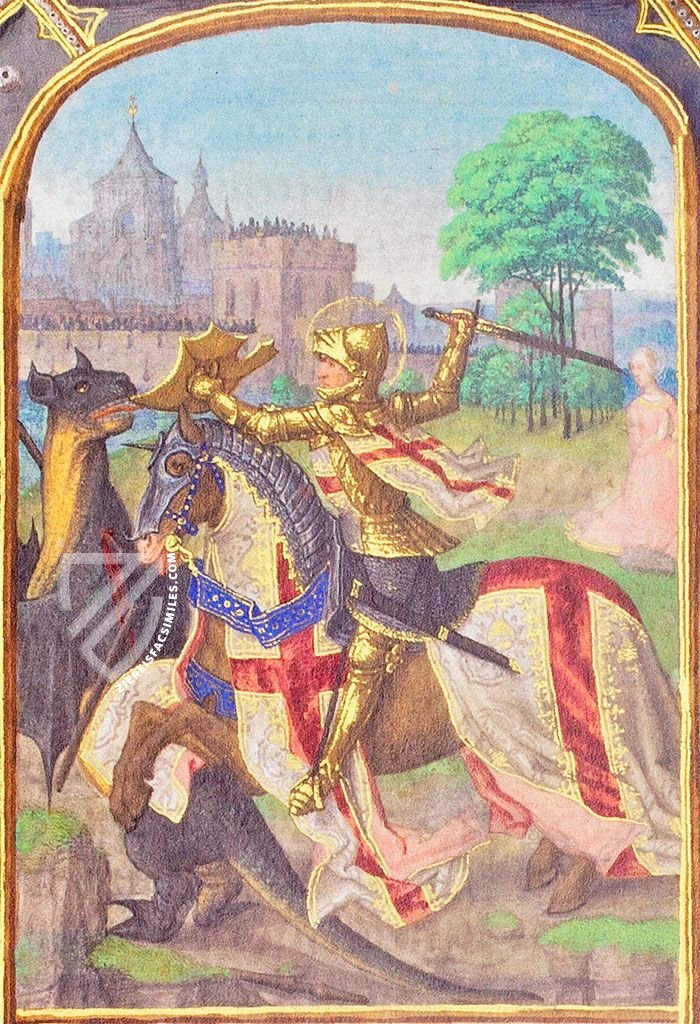
Prayer Book of Duke John Albert I of Mecklenburg
Massacre of the Innocents
“Then Herod, when he saw that he was deceived by the wise men, was exceedingly angry; and he sent forth and put to death all the male children who were in Bethlehem and in all its districts, from two years old and under, according to the time which he had determined from the wise men.” (Matt. 2:16).
This violent episode regained popularity among Renaissance artists, who used it to compare the atrocities of contemporary religious wars with the brutality of antiquity. Depicted with the garb and architecture of the 15th century, this miniature is remarkable for the posturing of the figures – both living and dead. King Herod is picture standing above the central arch with his retainers and looking down at the slaughter.
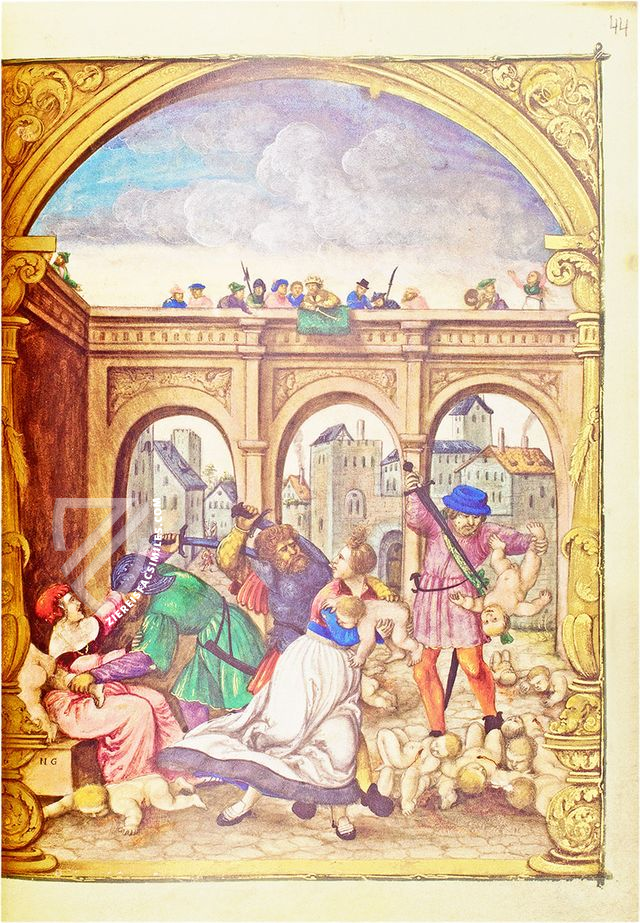
#1 Gebetbuch Herzogs Johann Albrecht von Mecklenburg
Languages: German
- Treatises / Secular Books
- Apocalypses / Beatus
- Astronomy / Astrology
- Bestiaries
- Bibles / Gospels
- Chronicles / History / Law
- Geography / Maps
- Saints' Lives
- Islam / Oriental
- Judaism / Hebrew
- Single Leaf Collections
- Leonardo da Vinci
- Literature / Poetry
- Liturgical Manuscripts
- Medicine / Botany / Alchemy
- Music
- Mythology / Prophecies
- Psalters
- Other Religious Books
- Games / Hunting
- Private Devotion Books
- Other Genres
- Afghanistan
- Armenia
- Austria
- Belgium
- Belize
- Bosnia and Herzegovina
- China
- Colombia
- Costa Rica
- Croatia
- Cyprus
- Czech Republic
- Denmark
- Egypt
- El Salvador
- Ethiopia
- France
- Germany
- Greece
- Guatemala
- Honduras
- Hungary
- India
- Iran
- Iraq
- Israel
- Italy
- Japan
- Jordan
- Kazakhstan
- Kyrgyzstan
- Lebanon
- Liechtenstein
- Luxembourg
- Mexico
- Morocco
- Netherlands
- Palestine
- Panama
- Peru
- Poland
- Portugal
- Romania
- Russia
- Serbia
- Spain
- Sri Lanka
- Sweden
- Switzerland
- Syria
- Tajikistan
- Turkey
- Turkmenistan
- Ukraine
- United Kingdom
- United States
- Uzbekistan
- Vatican City
- A. Oosthoek, van Holkema & Warendorf
- Aboca Museum
- Ajuntament de Valencia
- Akademie Verlag
- Akademische Druck- u. Verlagsanstalt (ADEVA)
- Aldo Ausilio Editore - Bottega d’Erasmo
- Alecto Historical Editions
- Alkuin Verlag
- Almqvist & Wiksell
- Amilcare Pizzi
- Andreas & Andreas Verlagsbuchhandlung
- Archa 90
- Archiv Verlag
- Archivi Edizioni
- Arnold Verlag
- ARS
- Ars Magna
- ArtCodex
- AyN Ediciones
- Azimuth Editions
- Badenia Verlag
- Bärenreiter-Verlag
- Belser Verlag
- Belser Verlag / WK Wertkontor
- Benziger Verlag
- Bernardinum Wydawnictwo
- BiblioGemma
- Biblioteca Apostolica Vaticana (Vaticanstadt, Vaticanstadt)
- Bibliotheca Palatina Faksimile Verlag
- Bibliotheca Rara
- Boydell & Brewer
- Bramante Edizioni
- Bredius Genootschap
- Brepols Publishers
- British Library
- C. Weckesser
- Caixa Catalunya
- Canesi
- CAPSA, Ars Scriptoria
- Caratzas Brothers, Publishers
- Carus Verlag
- Casamassima Libri
- Centrum Cartographie Verlag GmbH
- Chavane Verlag
- Christian Brandstätter Verlag
- Circulo Cientifico
- Club Bibliófilo Versol
- Club du Livre
- CM Editores
- Collegium Graphicum
- Collezione Apocrifa Da Vinci
- Comissão Nacional para as Comemorações dos Descobrimentos Portugueses
- Coron Verlag
- Corvina
- CTHS
- D. S. Brewer
- Damon
- De Agostini/UTET
- De Nederlandsche Boekhandel
- De Schutter
- Deuschle & Stemmle
- Deutscher Verlag für Kunstwissenschaft
- DIAMM
- Droz
- E. Schreiber Graphische Kunstanstalten
- Ediciones Boreal
- Ediciones Grial
- Ediclube
- Edições Inapa
- Edilan
- Editalia
- Edition Deuschle
- Edition Georg Popp
- Edition Leipzig
- Edition Libri Illustri
- Editiones Reales Sitios S. L.
- Éditions de l'Oiseau Lyre
- Editions Medicina Rara
- Editorial Casariego
- Editorial Mintzoa
- Editrice Antenore
- Editrice Velar
- Edizioni Edison
- Egeria, S.L.
- Eikon Editores
- Electa
- Emery Walker Limited
- Enciclopèdia Catalana
- Eos-Verlag
- Ephesus Publishing
- Ernst Battenberg
- Eugrammia Press
- Extraordinary Editions
- Fackelverlag
- Facsimila Art & Edition
- Facsimile Editions Ltd.
- Facsimilia Art & Edition Ebert KG
- Faksimile Verlag
- Feuermann Verlag
- Folger Shakespeare Library
- Franco Cosimo Panini Editore
- Friedrich Wittig Verlag
- Fundación Hullera Vasco-Leonesa
- G. Braziller
- Gabriele Mazzotta Editore
- Gebr. Mann Verlag
- Gesellschaft für graphische Industrie
- Getty Research Institute
- Giovanni Domenico de Rossi
- Giunti Editore
- Graffiti
- Grafica European Center of Fine Arts
- Guido Pressler
- Guillermo Blazquez
- Gustav Kiepenheuer
- H. N. Abrams
- Harrassowitz
- Harvard University Press
- Helikon
- Hendrickson Publishers
- Henning Oppermann
- Herder Verlag
- Hes & De Graaf Publishers
- Hoepli
- Holbein-Verlag
- Houghton Library
- Hugo Schmidt Verlag
- Idion Verlag
- Il Bulino, edizioni d'arte
- ILte
- Imago
- Insel Verlag
- Insel-Verlag Anton Kippenberger
- Instituto de Estudios Altoaragoneses
- Instituto Nacional de Antropología e Historia
- Introligatornia Budnik Jerzy
- Istituto dell'Enciclopedia Italiana - Treccani
- Istituto Ellenico di Studi Bizantini e Postbizantini
- Istituto Geografico De Agostini
- Istituto Poligrafico e Zecca dello Stato
- Italarte Art Establishments
- Jan Thorbecke Verlag
- Johnson Reprint Corporation
- Josef Stocker
- Josef Stocker-Schmid
- Jugoslavija
- Karl W. Hiersemann
- Kasper Straube
- Kaydeda Ediciones
- Kindler Verlag / Coron Verlag
- Kodansha International Ltd.
- Konrad Kölbl Verlag
- Kurt Wolff Verlag
- La Liberia dello Stato
- La Linea Editrice
- La Meta Editore
- Lambert Schneider
- Landeskreditbank Baden-Württemberg
- Leo S. Olschki
- Les Incunables
- Liber Artis
- Library of Congress
- Libreria Musicale Italiana
- Lichtdruck
- Lito Immagine Editore
- Lumen Artis
- Lund Humphries
- M. Moleiro Editor
- Maison des Sciences de l'homme et de la société de Poitiers
- Manuscriptum
- Martinus Nijhoff
- Maruzen-Yushodo Co. Ltd.
- MASA
- Massada Publishers
- McGraw-Hill
- Metropolitan Museum of Art
- Militos
- Millennium Liber
- Müller & Schindler
- Nahar - Stavit
- Nahar and Steimatzky
- National Library of Wales
- Neri Pozza
- Nova Charta
- Oceanum Verlag
- Odeon
- Orbis Mediaevalis
- Orbis Pictus
- Österreichische Staatsdruckerei
- Oxford University Press
- Pageant Books
- Parzellers Buchverlag
- Patrimonio Ediciones
- Pattloch Verlag
- PIAF
- Pieper Verlag
- Plon-Nourrit et cie
- Poligrafiche Bolis
- Presses Universitaires de Strasbourg
- Prestel Verlag
- Princeton University Press
- Prisma Verlag
- Priuli & Verlucca, editori
- Pro Sport Verlag
- Propyläen Verlag
- Pytheas Books
- Quaternio Verlag Luzern
- Reales Sitios
- Recht-Verlag
- Reichert Verlag
- Reichsdruckerei
- Reprint Verlag
- Riehn & Reusch
- Roberto Vattori Editore
- Rosenkilde and Bagger
- Roxburghe Club
- Salerno Editrice
- Saltellus Press
- Sandoz
- Sarajevo Svjetlost
- Schöck ArtPrint Kft.
- Schulsinger Brothers
- Scolar Press
- Scrinium
- Scripta Maneant
- Scriptorium
- Shazar
- Siloé, arte y bibliofilia
- SISMEL - Edizioni del Galluzzo
- Sociedad Mexicana de Antropología
- Société des Bibliophiles & Iconophiles de Belgique
- Soncin Publishing
- Sorli Ediciones
- Stainer and Bell
- Studer
- Styria Verlag
- Sumptibus Pragopress
- Szegedi Tudomànyegyetem
- Taberna Libraria
- Tarshish Books
- Taschen
- Tempus Libri
- Testimonio Compañía Editorial
- Thames and Hudson
- The Clear Vue Publishing Partnership Limited
- The Facsimile Codex
- The Folio Society
- The Marquess of Normanby
- The Richard III and Yorkist History Trust
- Tip.Le.Co
- TouchArt
- TREC Publishing House
- TRI Publishing Co.
- Trident Editore
- Tuliba Collection
- Typis Regiae Officinae Polygraphicae
- Union Verlag Berlin
- Universidad de Granada
- University of California Press
- University of Chicago Press
- Urs Graf
- Vallecchi
- Van Wijnen
- VCH, Acta Humaniora
- VDI Verlag
- VEB Deutscher Verlag für Musik
- Verlag Anton Pustet / Andreas Verlag
- Verlag Bibliophile Drucke Josef Stocker
- Verlag der Münchner Drucke
- Verlag für Regionalgeschichte
- Verlag Styria
- Vicent Garcia Editores
- W. Turnowski Ltd.
- W. Turnowsky
- Waanders Printers
- Wiener Mechitharisten-Congregation (Wien, Österreich)
- Wissenschaftliche Buchgesellschaft
- Wissenschaftliche Verlagsgesellschaft
- Wydawnictwo Dolnoslaskie
- Xuntanza Editorial
- Zakład Narodowy
- Zollikofer AG

